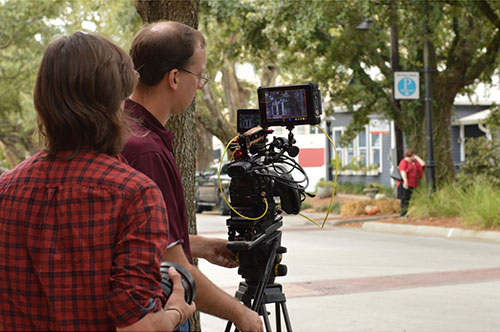University Television Center produces nationally recognized 'Resilience to Future Flooding' video series

University Television Center Senior Producer James Parker, left, and UTC Director David Garraway record footage in Ocean Springs for the center’s “Resilience to Future Flooding” video series. The project was completed for the Northern Gulf of Mexico Sentinel Site Cooperative (NGOM SSC) and received a silver award from the Association of Natural Resource Extension Professionals. PHOTO: Christina Mohrman | Gulf of Mexico Alliance
The University Television Center at Mississippi State is the recipient of a prestigious honor from the Association of Natural Resource Extension Professionals.
The video series “Resilience to Future Flooding” is a silver award winner in the TV/Video Series category of ANREP’s annual awards program. The project was completed for the Northern Gulf of Mexico Sentinel Site Cooperative (NGOM SSC), a partnership focused on sea-level rise and inundation in the northern Gulf and one of five cooperatives within NOAA’s Sentinel Site Program.
The series includes two sets of videos, with the first focusing on the science and effect of sea-level rise in the northern Gulf of Mexico, and potential solutions to address or avoid these impacts. The second set highlights case studies of measures that communities have taken around the Gulf to reduce their vulnerability to sea-level rise. The videos are available for viewing online at http://masgc.org/northern-gulf-of-mexico-sentinel-site-co/resilience-to-future-flooding#vertngom.
“Providing top-level services to our clients is always the TV Center’s highest priority, and we are delighted when the products we create receive national recognition,” said David Garraway, center director. “It’s an honor to represent MSU in the work we do every day, and this award is another reminder that our productions are impacting audiences across the region and country.”
The ANREP accolade also recognizes the collaborative partnership of the project team, which includes NGOM SSC Program Coordinator Renee Collini and NGOM SSC Project Coordinator Mikaela Heming, both with the Mississippi-Alabama Sea Grant Consortium. Collini is an extension instructor and Heming an extension associate for MSU’s Coastal Research and Extension Center based in Biloxi.
Other project contributors include Carrie Stevenson, coastal sustainability agent, University of Florida; Stephen Deal, extension specialist (land use planning), University of Mississippi; Melissa Daigle, research associate and resiliency specialist, Louisiana State University; Rhonda Price, deputy director, Mississippi Department of Marine Resources, Coastal Restoration and Resiliency; Christine Buckel, NOAA ecologist; David Kidwell, director of NOAA’s National Centers for Coastal Ocean Science Competitive Research Program; Marian Hanisko, NOAA coastal management specialist; and Christina Mohrman, program coordinator, Gulf of Mexico Alliance.
The Northern Gulf of Mexico Sentinel Site Cooperative incorporates the coastline and barrier islands from the Suwannee River in the Florida panhandle west to the Pearl River, at the state line between Mississippi and Louisiana. The area includes the Apalachicola, Weeks Bay and Grand Bay National Estuarine Research Reserves, as well as several national wildlife refuges and national parks.
This region, with low level topography and extensive marsh and other critical habitats, is highly susceptible to the effects of sea-level change. The combined effects of sea-level rise and tropical storms can have dramatic impacts on coastal communities and ecosystems, including flooding, faster erosion, land loss and saltwater intrusion into freshwater resources. Impacts also can reach offshore to valuable resources like oyster reefs and seagrass beds. For more, visit www.ngomssc.org.
Project team members said sea-level rise is a ubiquitous issue in the coastal zone, directly affecting coastal communities. They explained that it is crucial for coastal decision-makers to understand how sea levels will rise and the options for addressing potential impacts.
“SLR science is complicated and advancing at a rapid pace, and practical solutions for small coastal communities are not well described or shared, making it difficult for coastal decision-makers to understand their vulnerabilities and options,” Heming said. “To reduce communication barriers around SLR science and potential actions to address risks, we developed these videos in collaboration with coastal decision-makers and MSU’s Television Center.”
Garraway said large projects like these are “truly a team effort that require the talents of everyone at the TV Center.”
“In particular, the work of senior producer Joey Goodsell and creative manager Hal Teasler on these features really made this video series special, and I appreciate their contributions to our science communication efforts,” he said.
The University Television Center is a division of MSU’s Office of Public Affairs. Learn more at www.utc.msstate.edu and www.opa.msstate.edu.
MSU is Mississippi’s leading university, available online at www.msstate.edu.
Sasha Steinberg | Public Affairs



